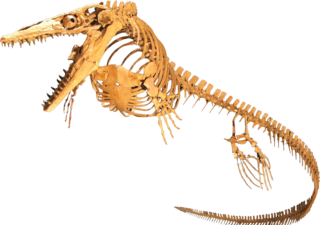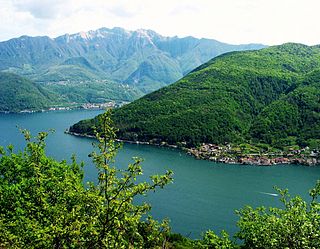Related Research Articles

Trilobites are extinct marine arthropods that form the class Trilobita. Trilobites form one of the earliest known groups of arthropods. The first appearance of trilobites in the fossil record defines the base of the Atdabanian stage of the Early Cambrian period and they flourished throughout the lower Paleozoic before slipping into a long decline, when, during the Devonian, all trilobite orders except the Proetida died out. The last trilobites disappeared in the mass extinction at the end of the Permian about 251.9 million years ago. Trilobites were among the most successful of all early animals, existing in oceans for almost 270 million years, with over 22,000 species having been described.

Redlichiida is an order of trilobites, a group of extinct marine arthropods. Species assigned to the order Redlichiida are among the first trilobites to appear in the fossil record, about halfway during the Lower Cambrian. Due to the difficulty to relate sediments in different areas, there remains some discussion, but among the earliest are Fallotaspis, and Lemdadella, both belonging to this order. The first representatives of the orders Corynexochida and Ptychopariida also appear very early on and may prove to be even earlier than any redlichiid species. In terms of anatomical comparison, the earliest redlichiid species are probably ancestral to all other trilobite orders and share many primitive characters. The last redlichiid trilobites died out before the end of the Middle Cambrian.

Gastropods, commonly known as slugs and snails, belong to a large taxonomic class of invertebrates within the phylum Mollusca called Gastropoda.

Old Red Sandstone, abbreviated ORS, is an assemblage of rocks in the North Atlantic region largely of Devonian age. It extends in the east across Great Britain, Ireland and Norway, and in the west along the eastern seaboard of North America. It also extends northwards into Greenland and Svalbard. These areas were a part of the paleocontinent of Euramerica (Laurussia). In Britain it is a lithostratigraphic unit to which stratigraphers accord supergroup status and which is of considerable importance to early paleontology. The presence of Old in the name is to distinguish the sequence from the younger New Red Sandstone which also occurs widely throughout Britain.

Mosasaurs are an extinct group of large aquatic reptiles within the family Mosasauridae that lived during the Late Cretaceous. Their first fossil remains were discovered in a limestone quarry at Maastricht on the Meuse in 1764. They belong to the order Squamata, which includes lizards and snakes.

Goniatids, informally goniatites, are ammonoid cephalopods that form the order Goniatitida, derived from the more primitive Agoniatitida during the Middle Devonian some 390 million years ago. Goniatites (goniatitids) survived the Late Devonian extinction to flourish during the Carboniferous and Permian only to become extinct at the end of the Permian some 139 million years later.

A microfossil is a fossil that is generally between 0.001 mm and 1 mm in size, the visual study of which requires the use of light or electron microscopy. A fossil which can be studied with the naked eye or low-powered magnification, such as a hand lens, is referred to as a macrofossil.
In the geological timescale, the Tithonian is the latest age of the Late Jurassic Epoch and the uppermost stage of the Upper Jurassic Series. It spans the time between 149.2 ±0.7 Ma and 145.0 ± 4 Ma. It is preceded by the Kimmeridgian and followed by the Berriasian.

The Emsian is one of three faunal stages in the Early Devonian Epoch. It lasted from 407.6 ± 2.6 million years ago to 393.3 ± 1.2 million years ago. It was preceded by the Pragian Stage and followed by the Eifelian Stage. It is named after the Ems river in Germany. The GSSP is located in the Zinzil'ban Gorge in the Kitab State Geological Reserve of Uzbekistan, 35 centimetres (14 in) above the contact with the Madmon Formation.

Monte San Giorgio is a Swiss mountain and UNESCO World Heritage Site near the border between Switzerland and Italy. It is part of the Lugano Prealps, overlooking Lake Lugano in the Swiss Canton of Ticino.

Megalneusaurus is an extinct genus of large pliosaurs that lived during the Oxfordian and Kimmeridgian stages of the Late Jurassic in what is now North America. It was provisionally described as a species of Cimoliosaurus by the geologist Wilbur Clinton Knight in 1895, before being given its own genus by the same author in 1898. The only species identified to date is M. rex, known from several specimens identified in the Redwater Shale Member, within the Sundance Formation, Wyoming, United States. A specimen discovered in the Naknek Formation in southern Alaska was referred to the genus in 1994. In Ancient Greek, the generic name literally translates to "large swimming lizard", due to the measurement of the fossils of the holotype specimen.

Megalaspides is an extinct genus from a well-known class of fossil marine arthropods, the trilobites. It lived during the later part of the Arenig stage of the Ordovician Period, approximately 478 to 471 million years ago.

In geology, the Arenig is a time interval during the Ordovician period and also the suite of rocks which were deposited during this interval.

The Bontnewydd palaeolithic site, also known in its unmutated form as Pontnewydd, is an archaeological site near St Asaph, Denbighshire, Wales. It is one of only three sites in Britain to have produced fossils of ancient species of humans and the only one with fossils of a classic Neanderthal. It is located a few yards east of the River Elwy, near the hamlet of Bontnewydd, near Cefn Meiriadog, Denbighshire.
The Dresbachian is a Maentwrogian regional stage of North America, lasting from 501 to 497 million years ago. It is part of the Upper Cambrian and is defined by four trilobite zones. It overlaps with the ICS-stages Guzhangian, Paibian and the lowest Jiangshanian.
Nozamichthys is an extinct genus of prehistoric bony fish that lived during the late Moscovian stage of the Pennsylvanian epoch in what is now Illinois, United States. Fossils were collected from the Mazon Creek fossil beds. The first part of the genus name is Mazon spelled backwards, and the second part means 'fish'.

Tarpon are fish of the genus Megalops. They are the only members of the family Megalopidae. Of the two species, one is native to the Atlantic, and the other to the Indo-Pacific Oceans.

Crustaceans may pass through a number of larval and immature stages between hatching from their eggs and reaching their adult form. Each of the stages is separated by a moult, in which the hard exoskeleton is shed to allow the animal to grow. The larvae of crustaceans often bear little resemblance to the adult, and there are still cases where it is not known what larvae will grow into what adults. This is especially true of crustaceans which live as benthic adults, more-so than where the larvae are planktonic, and thereby easily caught.

Crustaceans are a group of arthropods that are a part of the subphylum Crustacea, a large, diverse group of mainly aquatic arthropods including decapods, seed shrimp, branchiopods, fish lice, krill, remipedes, isopods, barnacles, copepods, opossum shrimps, amphipods and mantis shrimp. The crustacean group can be treated as a subphylum under the clade Mandibulata. It is now well accepted that the hexapods emerged deep in the Crustacean group, with the completed group referred to as Pancrustacea. The three classes Cephalocarida, Branchiopoda and Remipedia are more closely related to the hexapods than they are to any of the other crustaceans.

Yamatosaurus is a genus of basal hadrosaurid from the Late Cretaceous (Maastrichtian)-aged Kita-Ama Formation of Awaji Island, Japan. The genus contains a single species, Yamatosaurus izanagii.
References
- 1 2 Sepkoski, Jack (2002). "A compendium of fossil marine animal genera (Trilobita entry)". Bulletins of American Paleontology. 364: 560. Retrieved 2008-01-12.